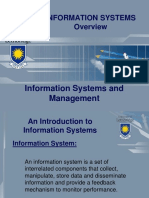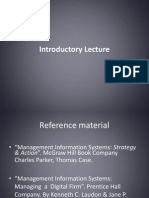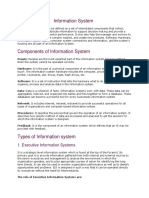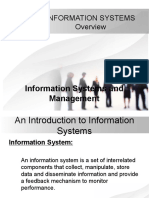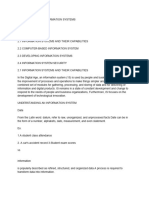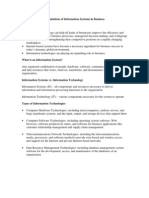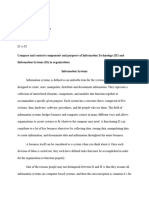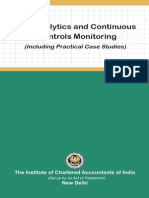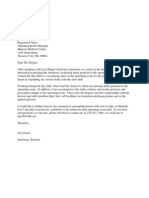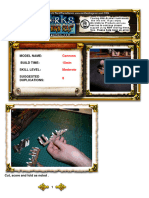IT APPLICATION TOOLS IN BUSINESS
BUSINESS AND INFORMATION TECHNOLOGY
Business Concepts
The word “business” Is traditionally defined as the exchange of products. However, its concept
activities have changed tremendously through time. At present, the word has taken on a technical
meaning as it focuses not only on trade but also on production, distribution, and the sale of goods and
services.
Information Technology
IT is defined as the study and application of computers, network and telecommunication that store,
manipulate, retrieve, manage, and send information. It includes a combination of software and
hardware resources that used together to perform various functions that people need in their
everyday life.
Modern IT is simply more than high technology and gadgetry. There are sophisticated computers
available in the market today that are fully equipped with modern software and capable of solving a
multitude of business and technical problems.
Information Systems and Their Capabilities
In the digital age, an information system (IS) is used by people and business organizations for the
movement of processes and operations to make things simpler and easier. It is a combined set of
modules for gathering, processing, and storing of data and for delivering of information and digital
products.
Data vs. Information
Data – from the Latin word, datum, refer to raw, unorganized, and unprocessed facts. Data can be in the
form of number alphabets, data, measurement, and even statement.
Examples of Data:
1. A student’s class attendance
2. A car’s accident record
3. The price of a meal at McDonalds
4. A student’s exam scores
Information – is popularly described as refined, structured, and organized data. A process is required
to transform data into information.
Examples of Information:
1. A financial statement
2. The average exam score in a class
For example, if Company XYZ wants to collect data to get feedback from its customers regarding its
services and performance, it must consider the following:
a. Indicators must be clearly defined to measure effective performance
b. Collect data must be complete, relevant, reliable, and accurate
c. Collected data must be gathered on time.
1
� d. Data must be convertible into information that is needed
e. Data must be entered into the computer system
f. Information must be analyzable using appropriate technological tools and allow for proper
interpretation.
System
A system can be defined as a collection of parts that interact, interconnect, and work together to
accomplish certain objectives. A subsystem is a part of a whole system that has its own area of
immediate focus.
Example, the Finance Department is a subsystem of any business organization.
The following are the types of systems:
a. Natural Systems – made by nature. Examples are weather systems such as typhoons, floods
and other forces of nature
b. Man-made Systems – a designed, developed, and implemented by human beings. Examples
are transportation systems, computer systems, and healthcare and education systems
A computer system takes inputs and processes them to create outputs.
Input – The fundamental idea of a computer system is that in every input, there is an expected output.
Users are required to input data into a specific program or computer system using input devices such
as a keyboard, mouse, scanner, and so on. The data can be texts, graphics, audio or even videos.
Process – Every computer has a microprocessor. The central processing unit or the CPU is the brain of
a computer and the one responsible for controlling all activities and handling input/output (I/O)
operations within a computer system. Data inputted into a system is processed by the CPU.
Output – is the result after data processing. It is usually presented using an output device.
Storage – Storage devices help users keep data, information and instructions from specific programs.
Information system (IS) - A man-made system that collects, stores, retrieves, processes, manages,
disseminates and analyze information needed to facilitate a business organization’s operational
functions and support its management in making decisions.
Information processing – refers to data processing functions that are commonly related to internal
operations (e.g., manufacturing) and economic and financial activities.
Data maintenance – refers to a system’s functional activities such as adding, saving, deleting,
updating, retrieving, and editing data from the master data.
The following are the three logical components of a business process within the scope of an IS:
1. Information process – refers to a portion of an IS closely related to a specified business
process. It plays a crucial role in making these 3 components work together to attain a specific
objective.
2. Operation process – refers to a man-made IS that consists of people, policies, procedures and
equipment whose main objective is to accomplish a certain goal of a particular business
organization
2
� 3. Management process – refers to a man-made IS that consists of people, policies, procedures,
and equipment whose main objective is to plan, manage, and control the overall operations of a
business organization.
Capabilities of an Information System
a. Processing transactions quickly and precisely
b. Managing large-capability storage and fast and easy access storage
c. Efficiently communicating through a network
d. Easing information overload for users
e. Supporting decision making
f. Serving as a competitive weapon against competitors
g. Uniting an organization through the coordination of its big and small groups
h. Strengthening organizational memory and learning and exploring new things
i. Determining the process of separating products and services
j. Automating Business Processes
Computer-Based Information Systems (CBIS) – use both computer and telecommunications
technology to perform certain tasks
Other types of Information systems
1. Transaction Processing Systems (TPS) – also known as real-time processing system. It is an
IS for all types of business transactions. It captures, stores, classifies, maintains, updates,
retrieves transaction data for record keeping and inputting data to CBIS
2. Management Information Systems (MIS) – consists of hardware and software applications
that support all the organization’s business transactions. This IS collects raw data from
different computer systems, analyzes and processes them, and reports them to assist and serve
in decision-making. An MIS as well as the study on how system works, should be considered.
3. Decision Support Systems (DSS) – helps companies identify and give solutions by making
decisions on how to solve problems including issues on raw data, documents, employee and
company profiling and management, and business model.
4. Executive Information Systems (EIS) – specialized DSS that assist senior executives of
organizations in making decisions. It provides easy access to valuable information necessary to
achieve organizational goals.
Phases of the System Development Life Cycle
1. Planning
2. Analysis
3. Design
4. Development
5. Testing
6. Implementation
7. Maintenance
Information System Security
Information security – mean protecting information and ISs form malicious software and
unauthorized access, use, disclosure, modification, disruption, or destruction
Information Security management – is the process of identifying the security controls to keep and
defend information assets.















